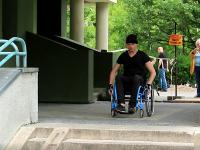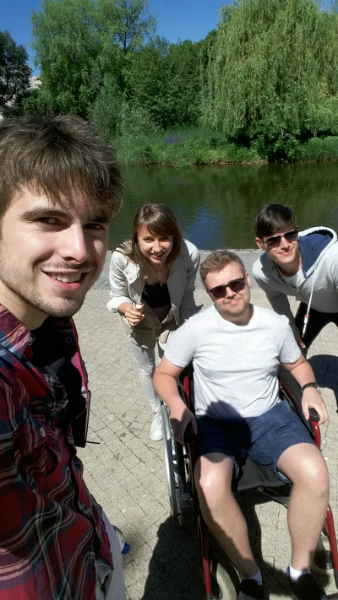Students from the Warsaw University of Technology want to help the disabled
To create an application that will make it easier and more convenient for disabled people to move — such is the aim of Civitas team from the ‘Smart City’ Interdepartmental Scientific Group. Our students keep honing their concept and count on support.
The design group consists of four people: Viktor Szabó and Maciej Szypulski from the Faculty of Geodesy and Cartography, Joanna Lemka from the Faculty of Architecture, and Sebastian Szczebiot from the Faculty of Power and Aeronautical Engineering.
'We have been thinking about the problems which the disabled have to face in today's cities,' says Viktor. 'From the very beginning, we have been concentrating on specific social groups and how we could help them,' adds Joanna.
That is how they came up with the idea to help the disabled. Importantly, as our students claim, on the market there is no other application similar to the one they are working on. Obviously, one can find city sites accessible for disabled people and check which means of transport are adapted for the needs of people in wheelchairs. This, however, has to be done individually. There is a lack of a single source of information in this respect. It is a major problem, especially when a person comes to visit a city they have never been to before.
How is it going to work?
Thanks to a navigation being created by Civitas team, a disabled person will be able to set an optimal route to the destination before they leave home. The routes will be personalised. 'Once the application is installed, the user will complete their profile,' explains Joanna. 'He or she will specify what kind of a curb or a ramp he or she is able to cross.'
That is not all. 'In our project, the creation of a community is the key,' says Viktor. 'It will be the disabled who will be adding and describing various obstacles which they find difficult to go through. Once they are approved by the administrator, they will be included in the route-drawing algorithm.'
20 metres is an effort
Our students have been developing the concept since April this year. At first, they met and discussed details. They have also talked with people using wheelchairs, established contact with two foundations, which help the handicapped, and even personally tested what obstacles stand in the way of the disabled. 'It is worse than we thought,' explains Joanna. 'There are puddles, crooked pavements, too steep ramps... Usually, it makes no difference whether you have to walk 300 or 500 metres to reach a bus stop; in a wheelchair, however, each 20 metres is a considerable effort.' 'I wanted to cross a road and I did not know if I should go left or right,' says Viktor. 'I chose left and there I found one flight of stairs,
then another one. I began to wonder whether I should keep going or turn back. Knowledge about the route would have been useful earlier, before leaving home.'
Such navigation could be used not only by the disabled but also by the elderly or parents with children in prams.
Support the project!
The application is not ready yet. The team is working on a prototype with a fragment of Warsaw. However, in order to further develop the concept, the team needs a financial and IT support. Students from Warsaw University of Technology also keep gathering data that could help them in their work. Just complete the online questionnaire.
'We perceive the project as our mission,' explains Viktor. 'We wish to help the disabled go out, we want to enable them to travel to work, to school, on holiday. Now, they are facing challenges they fear.'
The members of Civitas team want officials, city planners and designers to pay attention to the problems of people in wheelchairs. 'Although cities and individual sites are becoming better and better adapted to the needs of the disabled, there is still plenty of work ahead,'
says Joanna.
Read more about the project on the website
Agnieszka Kapela
Office for Promotion and Information









